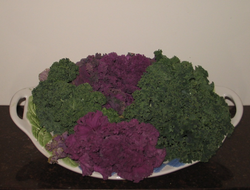Kale: A versatile dark green leafy vegetable
Published: February 04, 2022
Kale, or borecole, is a dark green or purple leafy vegetable.
An Acephala cultivar which is included in the species Brassica oleracea commonly known as the cabbage group.
Other vegetables included in this species are broccoli, Brussels sprouts, cauliflower, collard greens, and spring greens.
Unlike these other vegetables the central leaves of kale do not form a solid head.
There are several kale cultivars: curly and plain leaved, rape kale, leaf and spear, and Cavolo nero which is alternatively known as black cabbage, Tuscan Cabbage, Tuscan kale, Lacinato and dinosaur kale.
Nutrient value
From a nutritional health perspective adding kale to your repertoire of vegetables can provide you with substantial amounts of an array of nutrients.
Where a range of values is provided for vitamins and minerals, women require the lower end of the range and men the upper end of the range.
Iron is the exception where women should obtain the upper end of the range provided.
A serving of kale provides significant amounts of several essential vitamins and minerals: beta carotene, vitamin C, vitamin K, calcium, and iron.
Within your body beta carotene is converted to vitamin A which is involved in vision, reproduction, cell differentiation and protein synthesis.
Vitamin C is required for collagen and thyroxin synthesis, amino acid metabolism and the absorption of iron.
Vitamin C is also thought to strengthen your immune system as well as being an antioxidant.
Vitamin K is necessary for blood clotting and the synthesis of bone protein...link to the full article to learn more.
References
1.
Gropper, S.S., Smith, J.L. & Groff, J.L. (2005). Advanced Nutrition and Human Metabolism (4thEd.). Belmont, CA: Thomson Wadsworth.
2.
Whitney, E. & Rady Rolfes, S. (2005). Understanding Nutrition. Belmont, CA: Thomson Wadsworth
3.

